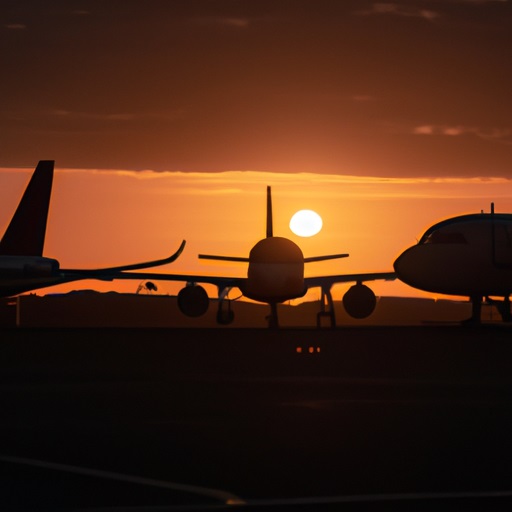
The Difference Between Major and Regional Airlines
The airline industry is made up of network legacy carriers, low-cost carriers, regional airlines, and cargo airlines. The major airlines and regional airlines work together to transport passengers across the country and around the world. However, there are some key differences between the major airlines and regional airlines in terms of business model, aircraft, routes, and more.
Major Airlines
The major airlines, also known as the network legacy carriers, are the large national and international airlines that provide service across the United States and to destinations around the world. The major airlines include:
- American Airlines
- Delta Air Lines
- United Airlines
- Southwest Airlines
- JetBlue Airways
- Alaska Airlines
These airlines operate medium to large narrow-body and wide-body aircraft such as the Boeing 737, 757, 767, 777, 787 and the Airbus A320 family on longer haul routes. They have hub-and-spoke route networks that allow passengers to connect through their hubs to reach a wide range of domestic and international destinations.
The major airlines offer first class, business class, premium economy, and main cabin seating on their aircraft. They provide amenities like in-flight entertainment, WiFi, power outlets, and food/beverage service on most flights. Most of the major airlines are also members of one of the three big global airline alliances – Oneworld, SkyTeam, or Star Alliance – which provide reciprocal benefits and allow easier connections across airlines.
Business Model
The major airlines operate via a hub-and-spoke model. This allows them to maximize the number of connections they can provide through their hubs and serve a wide range of markets, domestic and international. They focus on serving business travelers, international travelers, and premium passengers who value schedule frequency, global networks, loyalty programs, amenities, and service.
Due to their large size and high operating costs, the profit margins at major airlines tend to be relatively slim compared to low-cost carriers. But their size allows them to capture huge numbers of passengers across their networks. Even a small profit margin per passenger results in substantial bottom line profits.
The major airlines use a combination of owned aircraft along with regional partner airlines to optimize their networks. They feed traffic from smaller cities through their hubs and on to major destinations on their mainline flights. Strategic partnerships with international airlines also extend their global reach.
Aircraft Fleet
The major airlines operate large fleets of aircraft. For example:
- American Airlines has nearly 947 aircraft
- Delta Air Lines has more than 943 aircraft
- United Airlines has about 800 aircraft
Their fleets are made up of regional, narrow-body, and wide-body aircraft. Regional jets include Embraer E-Jets and Bombardier CRJ aircraft typically configured with first class, economy plus, and economy seating.
Narrow-body aircraft like the Boeing 737 and Airbus A320 families are used for short to medium-haul domestic routes configured with first class, extra legroom economy, and standard economy seating.
Wide-body aircraft including the Boeing 777, 787, Airbus A330, and A350 are used for long haul flights and may offer first class suites, business class lie-flat seating, premium economy, and economy class.
The use of different sized aircraft allows the major airlines to optimize the capacity on each route they serve. They can shift aircraft around their networks to respond to changes in demand. Their large aircraft fleets also provide redundancy to help recover quickly from disruptions like maintenance issues or weather delays.
Routes
The major airlines serve an extensive domestic route network focused around their major hubs. For example, American Airlines hubs include Dallas/Fort Worth, Charlotte, Chicago, Miami, Philadelphia, Phoenix, and Washington D.C. This allows them to connect passengers efficiently between hundreds of cities across the United States.
They also serve a wide range of international destinations in Europe, Asia, South America, Australia, and more. International routes may focus on business destinations like New York to London or leisure destinations like Los Angeles to Sydney. Global alliance partnerships expand their international reach by allowing partners to connect passengers across both airlines’ networks.
Within their domestic networks, major airlines have dominance in their hub cities. This allows them to offer high frequency service for connecting passengers. For example, Delta may offer hourly flights between Cincinnati and Atlanta to facilitate connections across Delta’s network. Even on routes where major airlines compete against low-cost carriers, they often match or beat the fares offered by discount airlines.
The extensive route networks allow the major airlines to attract both business and leisure travelers who want access to hundreds of destinations on one airline. Their frequent flyer programs also incentivize loyalty from frequent travelers.
Regional Airlines
Regional airlines operate short-haul flights on behalf of the major airlines. They primarily connect smaller markets and communities to the major airline hubs and focus cities. There are two main types of regional airlines:
Regional Brands Owned by Major Airlines
Some regionals are wholly owned subsidiaries and fly under the brand of the major airline, for example:
- American Eagle (owned by American Airlines)
- Delta Connection (owned by Delta Air Lines)
- United Express (owned by United Airlines)
By having their own regional airlines operate smaller aircraft on low density routes, the major carriers can serve more markets than they could only operating mainline flights. They tailor the passenger experience on regional airline flights to match their mainline service in order to present a seamless product.
Independent Regional Airlines
There are also independently owned and operated regional airlines that fly routes under contract agreements with the major carriers on a fee basis. These airlines include:
- Republic Airways (flies for American Eagle, Delta Connection, and United Express)
- SkyWest Airlines (flies for Alaska Airlines, American Eagle, Delta Connection, and United Express)
- Endeavor Air (flies as Delta Connection)
- GoJet Airlines (flies as Delta Connection and United Express)
- Compass Airlines (flies for American Eagle and Delta Connection)
- Envoy Air (flies as American Eagle)
- Piedmont Airlines (flies as American Eagle)
The independent regional airlines provide the aircraft, flight crews, and maintenance while following the brand standards of the major carrier they are flying on behalf of. This provides the major airlines with flexibility to adjust regional capacity as needed.
Aircraft Fleet
Regional airlines exclusively operate smaller aircraft optimized for short-haul flying. Typical regional airline aircraft include:
- Bombardier CRJ100/200/700/900/1000 seating 50-100 passengers
- Embraer E170/175/190/195 seating 70-124 passengers
- ATR-42 and ATR-72 turboprops seating 40-78 passengers
These smaller jets and turboprops allow for efficient operations from small airports and the ability to profitably serve routes with lower passenger demand. The aircraft often feature only first class and main cabin seating without amenities like seatback entertainment systems.
By utilizing regional aircraft on shorter flights, the major airlines can right-size capacity in each market and serve a wider range of airports they couldn’t reach cost-effectively with only mainline aircraft.
Routes
Regional airlines connect smaller cities and communities to the big airline hubs and focus cities. For example, American Eagle might fly from a city like Syracuse, NY to any of American’s hubs like Charlotte, Chicago O’Hare, Dallas/Fort Worth, Los Angeles, Miami, Philadelphia, Phoenix, or Washington Reagan.
This provides seamless one-stop connections to American’s extensive long-haul network. It allows American to sell tickets from Syracuse through their hub cities even though the first leg is operated by a regional partner. Similar small communities across the country are linked to major airline hubs by regional airline flights.
Some regional flights also serve shorter routes directly between focus cities for the major airlines. For example, Delta Connection might fly between Delta’s hubs in Cincinnati, Detroit, and Minneapolis-St. Paul. And United Express may fly between United’s hubs like Denver, Houston Bush, and San Francisco.
This point-to-point service between focus cities provides additional connectivity for the major carriers. It also allows frequency and schedules that cater to business travelers. The regional flights carry the major airline’s code and can be booked just like mainline flights.
Comparison of Major Airlines and Regional Airlines
Major Airlines:
- Operate medium and large narrow-body and wide-body jets
- Long haul domestic and international routes
- Full service model with first class, business class on long haul flights
- Offer seatback IFE, WiFi, etc. on mainline aircraft
- Focus on business travelers, international traffic, and premium passengers
- Large route networks and global alliances
- Operate own brand identity and aircraft paint schemes
- Major global brands like American, Delta, United
- Direct relationship with passengers as main operating airline
Regional Airlines:
- Operate smaller regional jets and turboprops
- Short-haul flights under 1,500 miles
- Mostly coach cabin with some first class seats
- Typically no IFE or WiFi on regional aircraft
- Connect smaller communities to major airline hubs
- Limited point-to-point flying between focus cities
- Operate under major airline brand names and paint schemes
- Lesser known regional brands like Republic, SkyWest, Endeavor
- Contract relationship flying on behalf of major airlines
In summary, the major airlines focus on operating large jets on longer haul routes while providing a full service premium passenger experience under their own brands. Regional airlines fill the role of flying smaller aircraft on shorter routes primarily to feed traffic to the majors’ hubs. They follow the brand standards of the major they are flying for and serve their route networks behind the scenes through contract agreements.
By leveraging both types of airlines, passengers benefit from expanded access to hundreds of destinations on the major carrier through seamless one-stop connections. The majors gain the efficiency of right-sizing aircraft for each market while regionals can profitably serve low density routes that wouldn’t sustain large jets. It’s a symbiotic relationship that has allowed the U.S. airline network to grow to provide extensive domestic and global connectivity.
Frequently Asked Questions About Major vs Regional Airlines
What are some key differences between low-cost carriers and major airlines?
The main differences are:
- Network: Low-cost carriers like Spirit and Frontier focus on point-to-point leisure markets while majors use hub-and-spoke route networks.
- Fares: LCCs offer cheap base fares but charge fees for amenities vs. majors include amenities in ticket price.
- Planes: Majors fly wide-body long haul routes internationally while LCCs stick to narrow-body aircraft.
- Seating: Large premium cabins on majors vs. all-economy configuration on LCCs.
- Service: Full service on majors vs. basic transport on LCCs.
How do codeshare agreements work between major and regional airlines?
Codesharing allows a regional flight to be booked under the major airline’s code and flight number. So a United Express flight operated by GoJet shows up as a United flight when booking tickets. This provides a seamless experience when connecting from a regional flight to a major airline flight through their hub airport.
Can you earn frequent flyer miles on regional airline flights?
Yes, flights on regional airlines earn miles in the frequent flyer program of the major airline they are operating on behalf of. So a flight on Endeavor Air as a Delta Connection route will earn SkyMiles. Miles earnings are based on the fare class purchased and follow the same structure as flights on the major airline.
Are regional airlines safer than major airlines?
No, regional airlines are held to the exact same rigorous FAA safety standards as the major airlines when it comes to maintenance, pilot training and qualifications, etc. Accident rates are comparably very low across both types of airlines. Regional airline pilots often accumulate experience before being hired at the major airlines.
Why don’t low-cost carriers use regional airlines?
The low-cost business model is based around point-to-point flying with quick turns using one fleet type to maximize utilization and efficiency. Regional aircraft with lower capacities and performance don’t fit this model. And outsourcing flying would introduce complexity and operational risk that runs counter to the LCC approach.
Do major airline elite status benefits apply on regional airline flights?
Typically yes, perks like free checked bags, priority boarding, and bonus miles will be honored for elite flyers on regional flights. Complimentary upgrades are less common due to the limited first class cabins on regional jets. But elites will be prioritized on upgrade waitlists when available.
Can you earn elite status by only flying regional airlines?
Usually no, most major airlines have requirements around minimum miles, segments, or dollars spent on the mainline airline flights. But all flight activity counts toward qualification, so regional flights help boost your totals toward elite status thresholds.
Do airline alliances like Star Alliance include regional airlines?
Yes, regional subsidiaries like United Express participate in their major airline’s alliance. So Star Alliance benefits apply on United Express flights just like mainline United flights. But independent regional carriers that contract with multiple majors are not part of any alliance.






